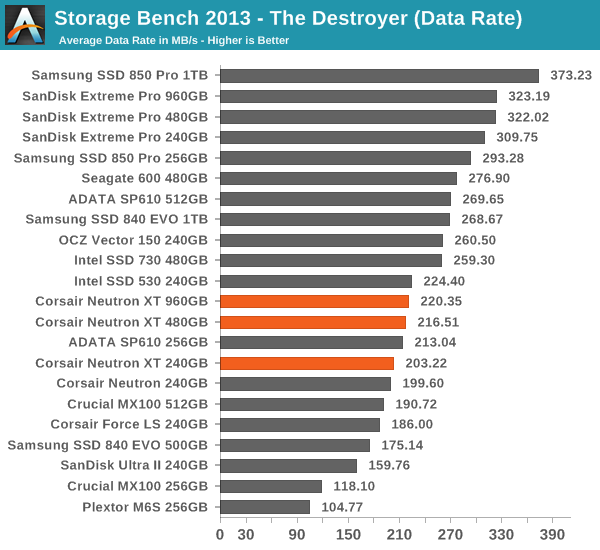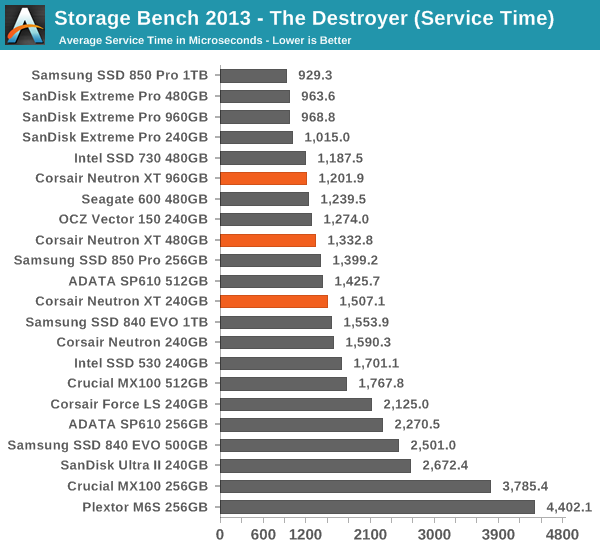Corsair Neutron XT (240GB, 480GB & 960GB) SSD Review: Phison S10 Debuts
by Kristian Vättö on November 17, 2014 9:00 AM ESTAnandTech Storage Bench 2013
Our Storage Bench 2013 focuses on worst-case multitasking and IO consistency. Similar to our earlier Storage Benches, the test is still application trace based – we record all IO requests made to a test system and play them back on the drive we are testing and run statistical analysis on the drive's responses. There are 49.8 million IO operations in total with 1583.0GB of reads and 875.6GB of writes. I'm not including the full description of the test for better readability, so make sure to read our Storage Bench 2013 introduction for the full details.
| AnandTech Storage Bench 2013 - The Destroyer | ||
| Workload | Description | Applications Used |
| Photo Sync/Editing | Import images, edit, export | Adobe Photoshop CS6, Adobe Lightroom 4, Dropbox |
| Gaming | Download/install games, play games | Steam, Deus Ex, Skyrim, StarCraft 2, BioShock Infinite |
| Virtualization | Run/manage VM, use general apps inside VM | VirtualBox |
| General Productivity | Browse the web, manage local email, copy files, encrypt/decrypt files, backup system, download content, virus/malware scan | Chrome, IE10, Outlook, Windows 8, AxCrypt, uTorrent, Ad-Aware |
| Video Playback | Copy and watch movies | Windows 8 |
| Application Development | Compile projects, check out code, download code samples | Visual Studio 2012 |
We are reporting two primary metrics with the Destroyer: average data rate in MB/s and average service time in microseconds. The former gives you an idea of the throughput of the drive during the time that it was running the test workload. This can be a very good indication of overall performance. What average data rate doesn't do a good job of is taking into account response time of very bursty (read: high queue depth) IO. By reporting average service time we heavily weigh latency for queued IOs. You'll note that this is a metric we have been reporting in our enterprise benchmarks for a while now. With the client tests maturing, the time was right for a little convergence.

The Neutron XT offers a healthy performance boost over the Force LS in our 2013 Storage Bench, but overall ends up in the middle-class. The Phison S10 platform appears to be very competitive with Silicon Motion's SM2246EN (ADATA SP610 in the graphs), but it can't challenge the high-end drives from Samsung, SanDisk, and OCZ.











56 Comments
View All Comments
magnusmundus - Monday, November 17, 2014 - link
I think the SATA 3 SSD market is already saturated. Read/write speeds and IOPS are pretty much as good as they are going to get. The only thing left to do is increase capacity and reduce costs. Why not start releasing drives for the new SATA Express interface, or more M.2 form factor drives? Too small a Z97 market? I guess we'll have to wait another year or so.sweenish - Monday, November 17, 2014 - link
I personally vote for skipping m.2 altogether. Let's just move right on to the PCI-E drives.TinHat - Monday, November 17, 2014 - link
+1hrrmph - Monday, November 17, 2014 - link
I think you mean let's skip the M.2 drives that use the (slower) SATA protocol, and move right on to the M.2 drives that use the (faster) PCI-E protocol.Samus - Monday, November 17, 2014 - link
Right. I have a Samsung M.2 PCIE drive, and after finally getting it to boot on my H97 board (using a EFI boot manager partition on my SATA SSD to point to its windows installation) all I can tell you is 1100MB/sec is pretty insane. It loads BF4 maps so fast I'm always waiting on the server...Mikemk - Monday, November 17, 2014 - link
So you want to lose a GPU?shank15217 - Tuesday, November 18, 2014 - link
The protocol is called NVMe, a PCI-E drive doesn't mean much.r3loaded - Tuesday, November 18, 2014 - link
Actually both the legacy AHCI and the new NVMe protocols can be used on a PCIe-attached drive. The consumer Plextor M6e and Samsung XP941 use AHCI for compatibility reasons, while the new Intel server drives use NVMe for better performance in server workloads.Kristian Vättö - Monday, November 17, 2014 - link
Every single controller house is working on a PCIe controller for SATA Express and M.2, but the development takes time.warrenk81 - Monday, November 17, 2014 - link
honest question, not trying to be snarky, but how has apple been shipping PCIe SSDs for almost two years and no one else is?